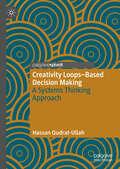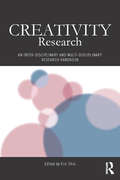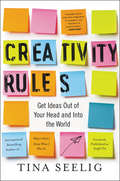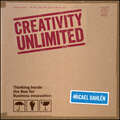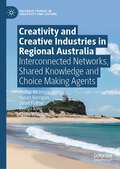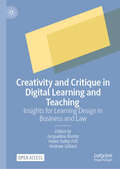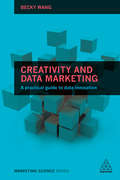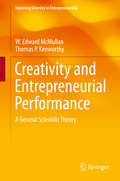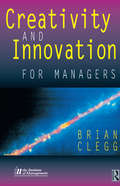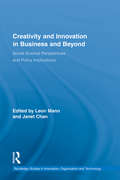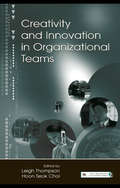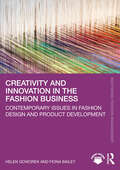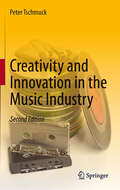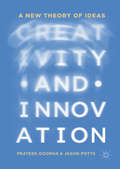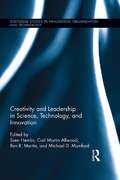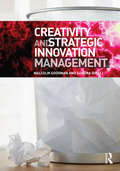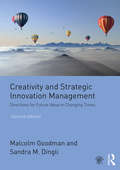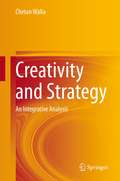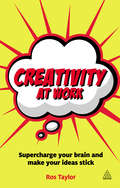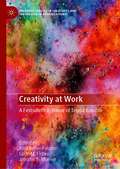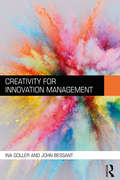- Table View
- List View
Creativity Loops–Based Decision Making: A Systems Thinking Approach
by Hassan Qudrat-UllahThis book presents an innovative framework for enhancing creativity in decision-making by applying systems thinking principles and tools. It is based on the premise that creativity is not a fixed trait that some people have and others don't, but a skill that can be learned and improved with practice and guidance. The book also argues that decision-making is not a linear or mechanical process that can be reduced to simple rules or formulas, but a dynamic and creative process that requires holistic and systemic thinking. The work also shows that systems thinking is not a complicated or abstract theory that only experts can use, but a practical and powerful tool that anyone can apply to understand and improve complex situations. The framework consists of six steps: problem identification, idea generation, idea selection, idea development, idea implementation, and monitoring and evaluating results and feedback. Readers will learn to use the framework to solve complex problems and generate innovative ideas in any context and domain. Through the systematic integration of existing models into a unified framework, the book contributes to ongoing dialogues regarding effective decision-making processes. It critically evaluates prominent models like the Creative Problem-Solving Model, the Rational Decision Making Model, and the Intuitive Decision Making Model. Researchers seeking insights into incorporating creativity into decision-making will find this book to be a valuable scholarly resource.
Creativity Research: An Inter-Disciplinary and Multi-Disciplinary Research Handbook (Routledge Studies in Innovation, Organizations and Technology)
by Eric ShiuCompared to its ‘cousin’ innovation, academic research on creativity has been less well covered in journals and books. This is despite the fact that creativity has a profound role in many different subject disciplines. This book is a unique collection of some of the latest research from a range of leading creativity researchers. Providing a clear understanding of the main concepts, this book: Introduces creativity from an inter-disciplinary perspective Discusses the environmental determinants of creativity development Explores creativity research in the differing disciplines of business, music and education Creativity Research will be of interest and importance to researchers across a variety of subject disciplines, as well as students and practitioners of creativity, innovation and organizational behaviour, amongst others.
Creativity Rules: Get Ideas Out of Your Head and into the World
by Tina SeeligInternational bestselling author and Stanford University professor Tina Seelig adapts her wildly popular creativity course to a practical guide on how to put your best ideas into action.For the past fifteen years, Professor Tina Seelig has taught her Stanford students how to creatively unleash their unique entrepreneurial spirits. In Creativity Rules, she shares this wisdom, offering inspiration and guidance to transform ideas into reality. Readers will learn how to work through the four steps of The Invention Cycle: Imagination (envisioning things that do not yet exist), Creativity (applying your imagination to address a challenge), Innovation (applying creativity to generate unique solutions), and Entrepreneurship (applying innovation, to bring ideas to fruition, where our ideas then gain the power to inspire the imaginations of others). Using each step to build upon the last, you can create something much complex, interesting, and powerful.Creativity Rules provides the essential knowledge to take a compelling idea and transform it into something extraordinary.
Creativity Unlimited
by Micael DahlenFlying in the face of current thinking, this book suggests that we do not need to 'think outside the box' in our quest for creativity, rather we should rethink the way we look 'inside the box'. This idea will resonate only too well with those who have endeavoured to be creative by thinking outside that box, only to have their attempts scuppered by the constraints of bureaucracy and organizational politics. Instead of fighting a losing battle, the author suggests that creativity should be worked at within the constraints of the organizational box, but that space needs to be grown and allowed to be shaken up. Only by experimenting, mutating and finding new directions can you uncover business paths that lead to success. The reader is encouraged not to free themselves from all their knowledge and experiences (the thinking outside the box method) but to use their knowledge and experience in new ways. The book is structured around three key steps: Expanding the box: so that the pieces of the puzzle in it can move around more freely Filling the box: with even more knowledge, and how to get these new pieces of the puzzle to connect with the existing ones Shaking the box: so that the pieces fall into new places and form new patterns. The book shows that anybody can be creative. The creative methods suggested in the book will be linked to real business examples from which techniques have been developed to help their implementation. Numerous exercises and 'eye-openers' form part of the practical implementation of Micael Dahlén's ideas. The book is framed by models and concepts of how creativity works (the creative process, the creative person and the creative result) and what its effects are.
Creativity and Copyright: Legal Essentials for Screenwriters and Creative Artists
by Howard Suber John L. GeigerInspired by Strunk & White's The Elements of Style, this elegant, short reference is the perfect guide for screenwriters and creative artists looking to succeed as industry professionals. Readers will quickly understand the laws that govern creativity, idea-making, and selling, and learn how to protect themselves and their works from the legal quagmires they may encounter. Written by an unrivaled pair of experts, John L. Geiger and Howard Suber, who use real-life case studies to cover topics such as clearance, contracts, collaboration, and infringement, Creativity and Copyright is poised to become an indispensable resource for beginners and experts alike.
Creativity and Creative Groups: Two Keys to Innovation
by Harvard Business Review PressEncouraging creativity is an important element to successful innovation. This chapter debunks certain myths about creativity and discusses the role of individual creativity and creative groups. The chapter offers six steps you can take to be more creative yourself and encourage creativity in your work groups.
Creativity and Creative Industries in Regional Australia: Interconnected Networks, Shared Knowledge and Choice Making Agents (Palgrave Studies in Creativity and Culture)
by Susan Kerrigan Phillip McIntyre Janet Fulton Claire Williams Evelyn KingThis book explores the relationship between creativity, creative people, and creative industries in regional Australia through examining lived experience. The authors draw on more than 100 qualitative interviews with creative workers, and contextualise this creative work within the broader social and cultural structures of Australia’s Hunter region (located north of Sydney, in New South Wales). An invaluable resource for anyone interested in creative ecosystems as well as creativity and innovation, this book is an ethnographic study using the Hunter region as a case connected to the national and global networks that typify the creative industry. This timely addition to the Palgrave Studies in Creativity and Culture series gives a unique insight into creativity and cultural production.
Creativity and Critique in Digital Learning and Teaching: Insights for Learning Design in Business and Law
by Jacqueline Baxter Andrew Gilbert Helen Selby-FellThis open access edited collection is aimed at educators, student services staff, and university management. It is timely in adopting a forward-facing view of various aspects of digital teaching and learning in business and law and provides a vital resource for those designing, managing or thinking about digital learning in both fields.
Creativity and Data Marketing: A Practical Guide to Data Innovation
by Becky WangThe world is moving towards universal connectivity at a dizzying rate; underpinning this complex system of incessant transaction, connection and digital experience is an infrastructure that generates a trail of data. This trail not only tells us about human behaviour, but provides vital insights into market dynamics, consumer behaviour, as well as the relationships we value and the culture we live in. Creativity and Data Marketing helps marketers access this data, find meaning in it and leverage it creatively to gain a competitive advantage. Creativity and Data Marketing addresses the need to analyse data creatively, and in particular how balancing tangible insights with creative market influence can maximise business innovation and results. The book clarifies where businesses can improve existing infrastructure, processes and activities, as well as finding new addressable markets ready to validate or rethink market demand. By identifying how and why a consumer interacts with touch points beyond paid media, for example forums, blog content, native advertising and word-of-mouth, Becky Wang presents a creativity and data blueprint on how businesses can make lucrative steps forward to innovate their products, services and communication strategies, laying the groundwork for long-term results.
Creativity and Entrepreneurial Performance: A General Scientific Theory (Exploring Diversity in Entrepreneurship)
by W. Edward Mcmullan Thomas P. KenworthyThe essential problem in entrepreneurship is improving the performance of entrepreneurs. The most important theories will be the ones that most enable us to predict and then ultimately influence entrepreneurial performance. This book develops a new and more accurate theory of entrepreneurial performance based in entrepreneurial creativity. The field of entrepreneurship has a long tradition of expecting entrepreneurial performance to be influenced by creativity, tracing back even before the pioneering work of Joseph Schumpeter (1883 to 1950), who defined entrepreneurship as creative-destruction--creating the new by supplanting or destroying the old. Subsequently, psychologist Robert Sternberg defined creativity as broadly encompassing creative aspects of personality, motivation, intellect, thinking style and relevant knowledge. Using Sternberg's definition of creativity, the authors reviewed the evidence directly linking entrepreneurial creativity and entrepreneurial performance, concluding that the linkage is both statistically and practically significant. In order to scientifically tie entrepreneurship to creativity the book pursues a number of major objectives: In parts one and two, the authors remind us of our scientific challenge in the light of the depressing levels of performance typically to be found in the real world of entrepreneurship and explores the limitations of the dominant paradigms driving research in the field of entrepreneurship today. In part three, they bring together existing evidence to demonstrate the predictive and explanatory powers of creativity in relation to entrepreneurship. In part four, they further explore correlations between creativity and entrepreneurial performance at the individual and macro or society, levels. In summary, the book offers a bold predictive theory linking entrepreneurial creativity to entrepreneurial performance, however neither as boldly as a definitional linkage nor as timidly as one in a hundred or so factors potentially explaining entrepreneurial performance. This result is a general scientific theory that offers a serious challenge to entrepreneurial scholars who are pursuing other means for understanding the causality of entrepreneurial performance.
Creativity and Innovation for Managers
by Brian CleggCreativity and Innovation for Managers will appeal to any manager responsible for getting more out of a business. Creative thinking, creative problem solving and creative idea generation have become essential business drivers. This book provides an excellent executive briefing for senior management to understand what business creativity is, how it can benefit the company, and how to get the most out of it. It looks at the pitfalls on the road to innovation and the ways to avoid them, pulling together the experiences of key practitioners in the field both in the UK and the US. By concentrating on the essentials, Creativity and Innovation In Brief is a waffle-free approach to creativity, providing a quick action focused and accessible insight into a complex topic.It provides; - a practical approach to business creativity without the hype;- an agenda for making innovation happen in your business- a real world view.
Creativity and Innovation in Business and Beyond: Social Science Perspectives and Policy Implications (Routledge Studies in Innovation, Organizations and Technology)
by Leon Mann Janet ChanIn many modern economies, creativity, the essential prerequisite for innovation, tends to be assumed or neglected while the catchphrase "innovation" dominates the field of business as the key to national performance and competitiveness. Creativity and Innovation in Business and Beyond illustrates the ways in which creativity spurs innovation and innovation enables creativity – not only in the realms of business and management, where the innovation is regularly acknowledged and discussed, but throughout the social sciences. With contributions from experts in fields as far-flung as policy, history, economics, economic geography, sociology, law, psychology, social psychology and education, in addition to business and management, this volume explores the manifold avenues for creativity and innovation at many levels including nation, region, city, institution, organisation, and team across a multitude of sectors and settings.
Creativity and Innovation in Organizational Teams (Organization and Management Series)
by Leigh L. Thompson Hoon-Seok ChoiCreativity and Innovation in Organizational Teams stemmed from a conference held at the Kellogg School of Management in June 2003 covering creativity and innovation in groups and organizations. Each chapter of the book is written by an expert and covers original theory about creative processes in organizations. The organization of the text reflects a longstanding notion that creativity in the world of work is a joint outcome of three interdependent forces--individual thinking, group processes, and organizational environment.Part I explores basic cognitive mechanisms that underlie creative thinking, and includes chapters that discuss cognitive foundations of creativity, a cognitive network model of creativity that explains how and why creative solutions form in the human mind, and imports a ground-breaking concept of "creativity templates" to the study of creative idea generation in negotiation context. The second part is devoted to understanding how groups and teams in organizational settings produce creative ideas and implement innovations. Finally, Part III contains three chapters that discuss the role of social, organizational context in which creative endeavors take place.The book has a strong international mix of scholarship and includes clear business implications based on scientific research. It weds the disciplines of psychology, cognition, and business theory into one text.
Creativity and Innovation in Organizations
by Teresa M. AmabileCreativity, the production of new and useful ideas by individuals or teams, can appear in many forms and many functions within firms of all kinds--from entrepreneurial start-ups to well-established enterprises. This note describes the varieties of creativity in organizations, and dispels common myths about what creativity is. Proposes a method for recognizing creativity, outlines the necessary components for individual creativity, and introduces a model of how organizational influences can affect creativity. Critiques some common methods for enhancing creativity, and discusses how creativity can result in innovation.
Creativity and Innovation in the Fashion Business: Contemporary Issues in Fashion Design and Product Development (Mastering Fashion Management)
by Helen Goworek Fiona BaileyCreativity and Innovation in the Fashion Business explores the ways in which creativity and innovation play a central role across the fashion industry, paying particular attention to design and technical perspectives. This topic is examined through careful theoretical analysis, incorporating the perspectives of multiple contributors who together possess a wealth of combined experience in creative and technical roles in the fashion business.Broad in scope, this textbook first provides a wide overview of creativity and innovative developments across the industry, before considering technical and digital innovation in production and product development, as well as trend forecasting. The final part of the book then consists of an exploration of sustainable innovation in design for fashion brands and retailers. Each chapter includes aims and summaries to structure learning and highlight key points, academic insights from thought leaders and interviews from industry and academia.A vital introductory textbook, Creativity and Innovation in the Fashion Industry is well-suited to undergraduate and postgraduate modules across subjects such as Fashion Business, Fashion Design and Manufacturing, Product Development, Innovation Management, and Buying and Merchandising. Online resources include PowerPoint slides and a test bank.
Creativity and Innovation in the Music Industry
by Peter TschmuckWhy did jazz become a dominant popular music genre in the 1920s and rock 'n' roll in the 1950s? Why did heavy metal, punk rock and hiphop find their way from sub-cultures to the established music industry? What are the effects of new communication technologies and the Internet on the creation of music in the early 21st century? These and other questions are answered by Peter Tschmuck through an integrated model of creativity and innovation that is based on an international history of music industry since Thomas A. Edison invented the phonograph in 1877. Thus, the history of the music industry is described in full detail. By discussing the historic process of music production, distribution and reception the author highlights several revolutions in the music industry that were caused by the inference of aesthetic, technological, legal, economic, social and political processes of change. On the basis of an integrated model of creativity and innovation, an explanation is given on how the processes and structures of the present music industry will be altered by the ongoing digital revolution, which totally changed the value-added network of the production, dissemination and use of music. For the second edition, the author has reworked chapter 9 in order to include all the developments which shaped the music industry in the first decade of the 21st century - from Napster to cloud-based music services and even beyond.
Creativity and Innovation: A New Theory of Ideas
by Jason Potts Prateek GoorhaIdeas are ubiquitous. They are the fundamental building blocks for all aspects of life. Yet, efforts to use ideas as a basic unit of analysis in a shared framework are rare. We often find it difficult to look past the artificial boundaries that academic disciplines and specialist fields of knowledge construct. In this book, the authors address this substantial lacuna by proposing an intuitive theory of ideas that serves as a trans-disciplinary basis for studying innovation and creativity. The theory proposed shows how new ideas emerge from contexts that rely on mechanisms, which were originally built on older and more central ideas. It demonstrates how these mechanisms help instantiate different perspectives on the same idea in variegated manners. By applying their theory to a variety of bat and ball sports, the authors illustrate the role that primitive ideas have on sports innovation, and explore further avenues for employing the theory in a number of different situations. This original book will be of interest to anyone who wishes to gain a deeper understanding of the processes of innovation and creativity, developed within a complex framework of ideas.
Creativity and Innovation: Everyday Dynamics and Practice
by Terence Lee Lauren O'Mahony Pia LebeckThis book provides a broad overview of the theory and practice of creativity and innovation. It is an interdisciplinary study that synthesizes the popular, complex and contemporary discourses on the topic. The approach of the book is centred on praxis, that is, it is grounded strongly in research-based theories, but aims to offer ideas on how to apply creativity and innovation in the everyday context. The authors present an expansive and well-informed perspective on creativity and innovation that transcends any single discipline or specialist area, making the book accessible, readable and memorable. Above all, the reader will be able read the book with a high degree of ease, grasp and retain key and critical concepts of creativity (and the creative process) and innovation (and the innovative process) as well as consider ways of applying them in their everyday lives across all vocations and professional contexts.
Creativity and Leadership in Science, Technology, and Innovation (Routledge Studies in Innovation, Organizations and Technology)
by Carl Martin Allwood Michael D. Mumford Sven Hemlin Ben R. MartinLeadership is vital to creativity and successful innovation in groups and organizations; leadership is however seldom studied in the academic literature as a creativity driver. One reason for the lack of attention paid to leadership’s effect on creativity may be the common belief that creativity cannot and should not be managed. Creative individuals and groups are regarded as, and indeed often are, autonomous and self-driving. From this belief the erroneous conclusion is drawn that there is no need for leadership in creative environments and situations. The better conclusion, proposed by this book, is that leadership not only stimulates creativity, but that such a leadership in the science, technology, and innovation fields should specifically possess at least two features: a) expertise in the field(s), and b) an ability to create, support, and encourage individuals, groups, and creative knowledge environments. A number of specialist authors in this volume offer original theoretical, empirical, and applied chapters that elucidate how to better organize and lead creative efforts in science, technology, and innovation. A number of important research questions are raised and answered, including: What kinds of leaderships are needed at different levels of S&T organizations for a creative output? What social and cognitive abilities and skills are needed for leadership in creative environments? How does leadership vary with different phases of the creative process? This book offers concrete analysis of how leaders and managers can facilitate, promote, and organize for creative performance in science, technology, and in innovating organizations, making it required reading for academic and industrial research leaders, scientists, and engineers.
Creativity and Strategic Innovation Management
by Malcolm GoodmanMany organizations in both the private and public sector are confronted with stiff challenges as they face rapid changes in the business environment. Understanding the causes of these changes is essential if organizations are to fashion suitable management responses. In a highly competitive and globalized scenario, business creativity provides the spark that fosters the development and implementation of innovation and organizational change. Increased understanding of the concepts of business creativity and strategic innovation management provides valuable insights into how organizations can change to meet new challenges. The book aims to: explain the nature of the acceleration in discontinuous change that is affecting the Western business environment emphasise the importance of taking a strategic approach to management responses to encourage creative and innovative skills indicate how a detailed strategic plan can be developed to support organizations intent on profitable survival in the twenty-first century. This textbook will be the perfect accompaniment to postgraduate courses on innovation management and creativity management. The wide-ranging approach means that the book will also be useful supplementary reading on a range of courses from management of technology to strategic management.
Creativity and Strategic Innovation Management: Directions for Future Value in Changing Times
by Malcolm Goodman Sandra M. DingliCreativity and Strategic Innovation Management was the first book to integrate innovation management with both change management and creativity to form an innovative guide to survival in rapidly changing market conditions. Treating creativity as the process, and innovation the result, Goodman and Dingli emphasise the importance of a strategic approach to management through fostering creative processes. Revised and updated for a second edition, this ground-breaking book now includes: A new section on contemporary themes in innovation management, such as the use of social media and sustainability. More coverage of entrepreneurship, ethics, diversity issues and the legal aspects of technology and innovation management. More international cases and real life examples. The book is also supported by a range of new tutor support materials. This textbook is an ideal accompaniment to postgraduate courses on innovation management and creativity management. The focused approach by Goodman and Dingli also makes it useful as supplementary reading on a range of courses from management of technology to strategic management.
Creativity and Strategy: An Integrative Analysis
by Chetan WaliaThis book provides an integrative analysis of creativity and strategic practices, particularly strategic problem formulation and strategic decision making. It examines the decision and not the individual as a unit of analysis, which leads to a deeper understanding of creative outcomes. It draws a correlation between strategic intent and creative outcomes, both positive and negative, and provides an integrated framework for understanding creativity. Finally, the book develops a creative strategic framework and draws conclusions for the practice of management and for future research.
Creativity at Work
by Ros TaylorWith the latest theories on the psychology of thinking, Ros Taylor sets out the pre-requisites needed for creativity to flourish. Different organizational cultures - without a patriarchal system - can inspire and motivate; understanding your own creative style can increase confidence; assessing the risks involved in any new idea or venture can ensure effective decision making; and by using social media, you can collaborate and share your ideas with others, adding another dimension to the creative process. Unlike other titles, Creativity at Work deals with all aspects of creativity, not just how to have ideas. It encompasses the psychology behind the idea and encourages the creative confidence you need to make your ideas happen. With questionnaires, case studies from companies such as Apple and Google, and insights from some of the most creative individuals in business, Creativity at Work helps you enhance your creativity, making sure you are never stuck for an idea again.
Creativity at Work: A Festschrift in Honor of Teresa Amabile (Palgrave Studies in Creativity and Innovation in Organizations)
by Colin M. Fisher Roni Reiter-Palmon Jennifer S. MuellerThis book brings together leading scholars in the field of creativity to provide an overview and examination of the work of Teresa Amabile, a pioneer of research on organizational creativity. The authors explore Dr. Amabile’s contributions to the modern study of creativity in organizations and her influence on current research. Further, they also reflect on how her work might be used to advance future research, particularly in the areas of componential theory and its extension as well as the consensual assessment technique. The contributors include both eminent and emerging scholars and their diverse backgrounds can be seen to reflect the breadth of the impact of Teresa Amabile’s work across the areas of the social psychology of creativity, creativity measurement, and application of this knowledge to understanding creativity and innovation in the workplace. This book will provide an invaluable resource to students and scholars of social psychology, creativity studies, industrial and organizational psychology, business and management.
Creativity for Innovation Management
by John Bessant Ina GollerCreativity for Innovation Management is a rigorous yet applied guide which illustrates what creativity is, why it matters, and how it can be developed at both individual and group levels. Unlike many technique-oriented books, this book will combine theory and practice, drawing on the latest research in psychology, organizational behaviour, innovation and entrepreneurship. This exciting new text outlines the necessary skills and competences for innovative and creative processes. It provides opportunities to explore these and also to develop them via a wide variety of activities linked to relevant tools and techniques, as well as a range of case studies. By working through key competence areas at personal and then team levels, students then have an opportunity to practice and enhance these skills. This will be complemented by online resources which will provide students with access to key tools and techniques plus activities to help develop their creativity. This textbook is ideal for students of innovation, management and entrepreneurship, as well as professionals in those industries that want to excel by developing and applying their own creativity at work.
